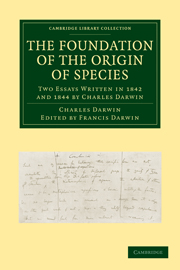Book contents
- Frontmatter
- Contents
- INTRODUCTION
- PART I
- PART II
- PART I
- PART II ON THE EVIDENCE FAVOURABLE AND OPPOSED TO THE VIEW THAT SPECIES ARE NATURALLY FORMED RACES, DESCENDED FROM COMMON STOCKS
- CHAPTER IV ON THE NUMBER OF INTERMEDIATE FORMS REQUIRED ON THE THEORY OF COMMON DESCENT; AND ON THEIR ABSENCE IN A FOSSIL STATE
- CHAPTER V GRADUAL APPEARANCE AND DISAPPEARANCE OF SPECIES
- CHAPTER VI ON THE GEOGRAPHICAL DISTRIBUTION OF ORGANIC BEINGS IN PAST AND PRESENT TIMES
- CHAPTER VII ON THE NATURE OF THE AFFINITIES AND CLASSIFICATION OF ORGANIC BEINGS
- CHAPTER VIII UNITY OF TYPE IN THE GREAT CLASSES; AND MORPHOLOGICAL STRUCTURES
- CHAPTER IX ABORTIVE OR RUDIMENTARY ORGANS
- CHAPTER X RECAPITULATION AND CONCLUSION
- INDEX
CHAPTER VII - ON THE NATURE OF THE AFFINITIES AND CLASSIFICATION OF ORGANIC BEINGS
Published online by Cambridge University Press: 07 September 2010
- Frontmatter
- Contents
- INTRODUCTION
- PART I
- PART II
- PART I
- PART II ON THE EVIDENCE FAVOURABLE AND OPPOSED TO THE VIEW THAT SPECIES ARE NATURALLY FORMED RACES, DESCENDED FROM COMMON STOCKS
- CHAPTER IV ON THE NUMBER OF INTERMEDIATE FORMS REQUIRED ON THE THEORY OF COMMON DESCENT; AND ON THEIR ABSENCE IN A FOSSIL STATE
- CHAPTER V GRADUAL APPEARANCE AND DISAPPEARANCE OF SPECIES
- CHAPTER VI ON THE GEOGRAPHICAL DISTRIBUTION OF ORGANIC BEINGS IN PAST AND PRESENT TIMES
- CHAPTER VII ON THE NATURE OF THE AFFINITIES AND CLASSIFICATION OF ORGANIC BEINGS
- CHAPTER VIII UNITY OF TYPE IN THE GREAT CLASSES; AND MORPHOLOGICAL STRUCTURES
- CHAPTER IX ABORTIVE OR RUDIMENTARY ORGANS
- CHAPTER X RECAPITULATION AND CONCLUSION
- INDEX
Summary
Gradual appearance and disappearance of groups.
It has been observed from the earliest times that organic beings fall into groups, and these groups into others of several values, such as species into genera, and then into sub-families, into families, orders, &c. The same fact holds with those beings which no longer exist. Groups of species seem to follow the same laws in their appearance and extinction, as do the individuals of any one species: we have reason to believe that, first, a few species appear, that their numbers increase; and that, when tending to extinction, the numbers of the species decrease, till finally the group becomes extinct, in the same way as a species becomes extinct, by the individuals becoming rarer and rarer. Moreover, groups, like the individuals of a species, appear to become extinct at different times in different countries. The Palseotherium was extinct much sooner in Europe than in India: the Trigonia was extinct in early ages in Europe, but now lives in the seas of Australia. As it happens that one species of a family will endure for a much longer period than another species, so we find that some whole groups, such as Mollusca, tend to retain their forms, or to remain persistent, for longer periods than other groups, for instance than the Mammalia. Groups therefore, in their appearance, extinction, and rate of change or succession, seem to follow nearly the same laws with the individuals of a species.
- Type
- Chapter
- Information
- The Foundation of the Origin of SpeciesTwo Essays Written in 1842 and 1844 by Charles Darwin, pp. 198 - 213Publisher: Cambridge University PressPrint publication year: 2009First published in: 1909

